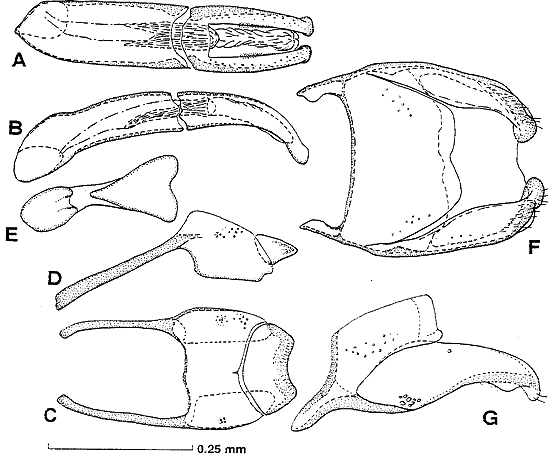Niponius obtusiceps Lewis, 1885
Niponius obtusiceps: Ohara, 1994, 72; Ohara, 1999a: 77.
Niponius obtusiceps Lewis, 1885b: 334 [Japan, Oyayama near Kumamoto
in Higo, and Ishikari river in Yezo in 1883]; Gardner, 1926: 3; Reichardt,
1929b: 275; Gardner, 1935: 5, t. 1, fig. 2; Reichardt, 1941: 69; Kryzhanovskij
and Reichardt, 1976: 78; Hisamatsu, 1985: 220 [key].
Japanese name: Tsuno-buto-hoso-emma-mushi.
Original description. "Cylindricus, elongatus,
brunneus, punctatus. Antennis pedibusque fufis, epistomo obtuso subfurcato,
thorace grosse necnon minute punctato. Elytris fasciis transversis medio
nigris. Propygidio punctato, pygidio bisulcato. Long. 4 mm."
Ohara (1994)
Description. Body cylindrical, moderately stout. Cuticle shining, black;
tarsi, antennae and projection of epistoma dark rufopiceous.
Projection of epistoma (Fig. 45 A, C) stout and long, its dorsal surface
with two transverse carinae. Apical third of head densely covered with fine
punctures and weakly transverse rugae, the punctures becoming sparser and
coarser posteriorly; median third of the surface coarsely punctate, the
punctures being separated by their own diameter to twice the diameter; basal
third with much smaller punctures than on median third, the punctures being
separated by three to five times their diameter; depression on mid line
deep on apical fourth.
Pronotum completely with marginal stria on lateral side, the stria strongly
carinate; surface irregularly scattered with deep, large and somewhat longitudinal
oblong punctures (Fig. 45D) and other fine punctures intermingled among
the large ones.
Epipleura of elytra completely with marginal elytral stria, which is
carinate and of which the apical end attains to near the posterior margin
of elytron; area between epipleural margin and elytral marginal stria impunctate
and extremely finely strigate. All dorsal and sutural striae represented
by rows of large punctures, the rows obsolete and their punctures becoming
finer on apical third; intervals among the rows impunctate on basal two-thirds,
but sometimes sparsely with several fine punctures, which are as large as
the pronotal fine ones, separated by their own diameter to twice the diameter
and become denser and finer posteriorly. Surface of elytra with weakly convex
on humeral area, and deeply transverse excavation on near the basal margin.
Propygidium (Fig. 45F) without large foveae, and sparsely covered with
coarse punctures which are twice as large as fine punctures of elytra, and
other fine punctures densely intermingled among the coarse ones. Pygidium
(Fig. 45F) with large, semicircular and deep foveae on basal two-thirds
on lateral area; area inside fovea sparsely and finely punctate; surface
between foveae sparsely covered with coarse punctures and intermingled fine
ones among the coarse ones; fine punctures present also on apical third
and along the margin.
Antennal grooves divided two parts; a deep furrow under eyes, and an
oblong fovea on basal half of underside of head (Fig. 45B); surface of the
groove densely clothed with fine punctures on apical half, the punctures
much sparser on basal half.
Prosternal lobe (Fig. 45E) transverse and narrow, its anterior margin
densely furnished with hair. Prosternal keel completely with two carinal
striae, of which the basal ends are united with each other in an arch; surface
of keel sparsely clothed with fine punctures.
Mesosternum longitudinally and shallowly sulcate on median third; area
of lateral third sparsely clothed with several fine punctures. Meso-metasternal
suture absent. Metasternum longitudinally, broadly and shallowly sulcate
on mid line; lateral metasternal stria strongly carinate, its apical end
extending posteriorly, and attaining to near apical fourth of metasternum.
Intercoxal disk of metasternum sparsely covered with coarse and longitudinal
oblong punctures. Lateral disk densely covered with coarse and round punctures,
which are a little coarser than those of intercoxal disk, the punctures
becoming sparser along the lateral metasternal stria.
Intercoxal disk of 1st abdominal sternum deeply striate on each lateral
side, the striae nearly complete, but not attaining to the apical margin;
surface densely and finely punctate, the punctures progressively sparser
and finer posteriorly.
Protibia slender and with three denticles on outer margin.
Remarks. Niponius obtusiceps can readily be recognized by the absence
of fovea on the propygidium and the short and stout projections of the epistoma.
No details are known about the habitat of this species. Specimens were
collected under the bark. Hisamatsu (1985) noted that this species was found
in tunnels made by cossonine beetles, Curculionidae.
Ohara (1999)
Additional description. Male genitalia as shown in Fig. 2. Ratio of paramera
length to basal piece length about 0.73.
Ohara (1994)
Specimens examined. [Honshû] <Tôkyô-to>
1 ex., Mt. Takao, 19/ii/1981, K. Horie leg. <Fukui-ken> 1Åä,
Ikegahara, Ôno-shi, 20/vi/1988, M. Saitô leg.
Distribution (Fig. 48). Japan (Honshû).
Ohara (1999a).
Specimens examined [additional records]. (Ohara, 1999a).
[Honshu] Aomori-ken: Oirase, Fukaura-machi (1 ex., 22/vii/1988, APM),
A. Abe.


Fig. 2. Niponius obtusiceps Lewis. Male genitalia. A: Aedeagus, dorsal
view. B: Ditto, lateral view. C: Ninth and 10th tergites, dorsal view. D:
Ditto, lateral view. E: Ninth sternum (spicule), dorsal view. F: Eight tergite
and sternum, dorsal view. G: Ditto, lateral view. (Ohara, 1999a).
Distribution. Japan (Hokkaido, Honshu, Kyushu).

Emmamushi.Home/Niponiinae/Niponius/References



